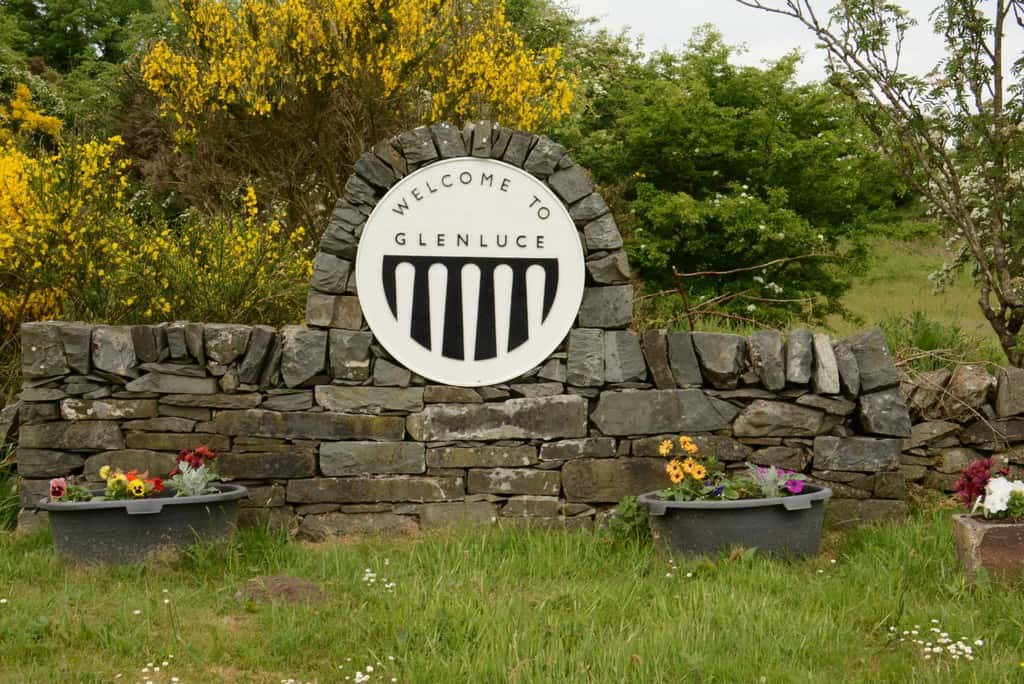The village of Glenluce between Newton Stewart and Stranraer in Dumfries and Galloway used to be a very busy place before the A75 bypassed it in the late ‘80s. Now its main street with pastel coloured cottages and houses is a much quieter spot for locals and visitors alike to enjoy. It’s location where the Rhins meets the Machars makes it a great starting point for exploring both peninsulas.

Read on to find out more about this historical area in Wigtownshire.

- Glenluce can trace its origins to the building of Glenluce Abbey in 1192. It was built by Cistercian monks from Dundrennan as a daughter house.
Illustrious visitors to the abbey include James IV, Robert the Bruce and Mary Queen of Scots.
It’s now a ruin although the Chapter House is intact. It’s said to have excellent acoustics – go and try them out for yourself!
The site is managed by Historic Environment Scotland and is open to the public on certain days between April and October.

2. As the abbey began to fall into disrepair, local landowners embraced recycling and used the stone in their own building projects.
Castle of Park is one such grand design. It’s an L-shaped tower house and a category A listed building.
It’s said to be haunted by a monk who was murdered by being walled up in one of the rooms! Others have seen a green lady floating around as well…

3. The parish church was vested by the king in 1587. In 1646 the parish was split in two to form Old Luce Parish Church and New Luce Parish Church.
Old Luce Parish Church records show a new loft and pews being built in 1775 and repairs to the aisle in 1778.
In 2016 the churches were reunited to form Luce Valley Church.

4.The village used to be known as Ballinclach, which means ‘stone village’, until the 15th century.
Glenluce means ‘valley of light’ and it’s not difficult to see why when you see its beautiful setting.

5.Wigtownshire County Golf Club is nearby and is a popular course since it is mainly on level ground.
It is just over 6,000 yards and par 70 and is known as ‘The County’.
It can be played all year round and visitors are welcome.
 6.The wizard and alchemist Michael Scott is said to have lived in Glenluce for a time.
6.The wizard and alchemist Michael Scott is said to have lived in Glenluce for a time.
He was a wandering scholar in the middle ages and there are many myths around his life and death.
One is that he had a vision that he would be killed by a stone hitting him on the head. He used to wear a cap as protection but took it off one day in church, was struck by a stone and died.

7. Glenluce is the starting point of the marked Pilgrim Way.
This is a 50-mile route that can be walked, cycled or ridden.
It finishes at the Isle of Whithorn on the Machars where there are many pilgrim locations to explore.

8. If you’d like a slightly shorter walk you can follow the Stairhaven Coastal Circuit.
It starts about a mile outside Glenluce and follows a clifftop route.
You can often see gannets over the water and on a clear day you’ll see their nesting site at Little Scares and Big Scares Rocks. You might also see Snaefell on the Isle of Man in the distance.

9. The village sits at the meeting of the Lady Burn and Water of Luce.
The Water of Luce offers salmon and sea trout fishing.
It is owned and managed by the Stair Estate and day permits are available.

10. Glenluce railway station was a victim of Dr Beeching in the 1960s.
The line was an important link between the east of the country and the port at Stranraer.
The impressive viaduct at the Water of Luce is a reminder of days gone by.









